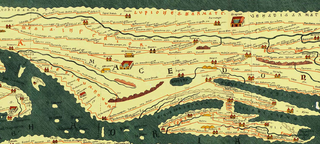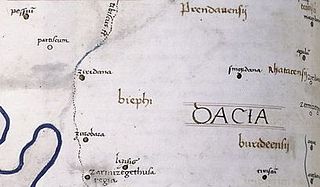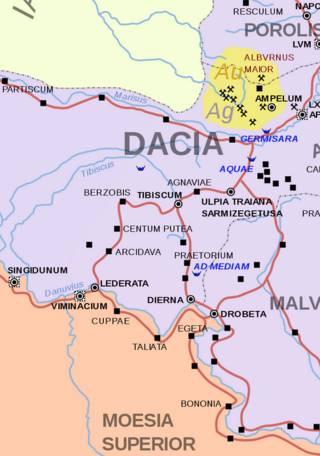
Sânnicolau Mare is a town in Timiș County, Romania, and the westernmost in the country. Located in the Banat region, along the borders with Serbia and Hungary, it has a population of 10,627 as of 2021.

Porolissum was an ancient Roman city in Dacia. Established as a military fort in 106 during Trajan's Dacian Wars, the city quickly grew through trade with the native Dacians and became the capital of the province Dacia Porolissensis in 124. It is one of the largest and best-preserved archaeological sites in modern-day Romania from the Roman Era. It is 8 km away from the modern city of Zalău, in Moigrad-Porolissum village, Mirsid Commune, Sălaj County.

Sucidava was a Dacian and Daco-Roman city situated in Corabia, Romania, on the north bank of the Danube. It developed from the 270s AD and especially after the construction of Constantine's Bridge the northern side of which it protected.

Cenad is a commune in Timiș County, Romania. It is composed of a single village, Cenad. The village serves as a customs point on the border with Hungary. Today's village was formed by merging Cenadu Mare and Cenadu Vechi in the 20th century.

Located in present-day Romania, Limes Porolissensis was the frontier of the Roman empire in Dacia Porolissensis, the northernmost of the three Dacian provinces. It was a defensive line dating from the 2nd century AD after the Conquest of Dacia up to the retreat of the Roman army from the region. The Limes was a complex network of over 200 observation towers, fortlets, palisades and ditches, and forts disposed in an arched line following the highland chain of the Meseș Mountains over 200 km from the Apuseni Mountains to Bistrița Mountains, and required as many as 16,000 soldiers to man and defend.

Amutria was a Dacian town close to the Danube and included in the Roman road network, after the conquest of Dacia.

Tibiscum was a Dacian town mentioned by Ptolemy, later a Roman fort and municipium. The ruins of the ancient settlement are located in Jupa, near Caransebeș, Caraș-Severin County, Romania. The Roman settlement here was one of the most important vestiges of classical antiquity in Banat.

Ziridava was a Dacian town located between Apulon and Tibiscum, mentioned by Ptolemy in the area of the Dacian tribe of Biephi.

The castra of Bulci was a fort in the Roman province of Dacia located on the western side of defensive line of forts, limes Daciae. Its ruins are located in Bulci.

Castra Buridava was a fort in the Roman province of Dacia, part of the frontier system of the Limes Alutanus, and near the Dacian and Roman town of Buridava.

Bersobis was an ancient Dacian fortress conquered in Trajan's Dacian Wars with the Romans. It became a legionary fortress in the Roman province of Dacia in the 2nd century AD. It is located near the town of Berzovia, Romania.

The Castra of Călugăreni was a fort in the Roman province of Dacia located on the north-western periphery of the modern village of Călugăreni, Romania. The fort was built in the 2nd century AD and abandoned in the 3rd century. Archaeological research also proved the existence of a nearby canabae.

The castra of Hoghiz was a fort in the Roman province of Dacia. The fort was built in the 2nd century AD, on the left bank of the Olt River, at a place where a Dacian settlement existing already in the 2nd century BC was unearthed. The fort and the nearby village were abandoned in the 3rd century AD. The ruins of the castra are located in Hoghiz, Romania.

Triphulum was a fort in the Roman province of Dacia. It was built in the 2nd century AD. Archaeological research also identified the nearby vicus. The castra and the nearby settlement were both abandoned in the 3rd century AD. The ruins of the fort are located in Orheiu Bistriței.

The castra of Aradul Nou was a fort in the Roman province of Dacia, located on the western side of the defensive line of forts, limes Daciae. It is situated near Arad, Romania.

Germisara was a fort in the Roman province of Dacia, now a ruin near the village of Cigmău in Romania.
Samum was a castrum (fort) in the Roman province of Dacia, situated at the very northern border of that territory. It lay on the right (northern) side of the river Someș, in historical and later known as Transylvania, in of present Romania. Remnants of this relatively small fortified camp lie within the cadastre of village Cășeiu, 1 kilometre (0.62 mi) on the southwest edge of the village.

The castra of Pietroasele was a Roman fort in Roman Dacia located in the centre of Pietroasele (Romania). It was built under Trajan after Trajan's Dacian Wars in about 106 AD but abandoned at the beginning of Hadrian's reign when Wallachia was given up to the Roxolani. It was used again at the beginning of the 3rd century in the reign of Caracalla. It was rebuilt by Constantine the Great after his victory over the Goths in 328 when Constantine created the Constantine Wall of the Dacian Limes. It was abandoned in the same century.
It was a fort in the Roman province of Dacia.
Partiscum was a fort in the Roman province of Dacia along the limes of Marisus river. It is the most Western fort of Dacia. Its ruins are located nearby Szeged, Csongrád-Csanád County, Hungary. Latest research showed that the most likely place was in Szeged, near the Tisza river, at the old Castle of Szeged.

















